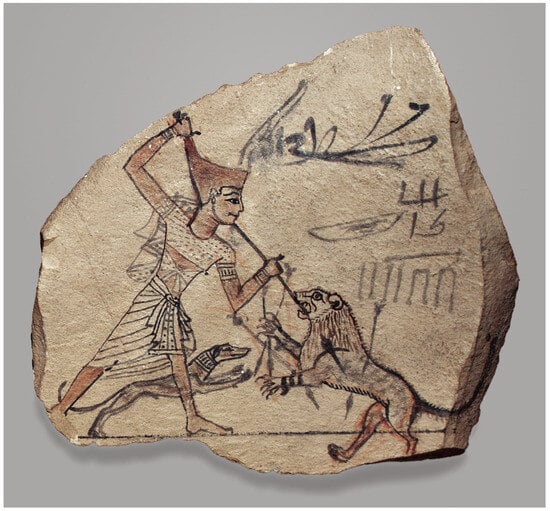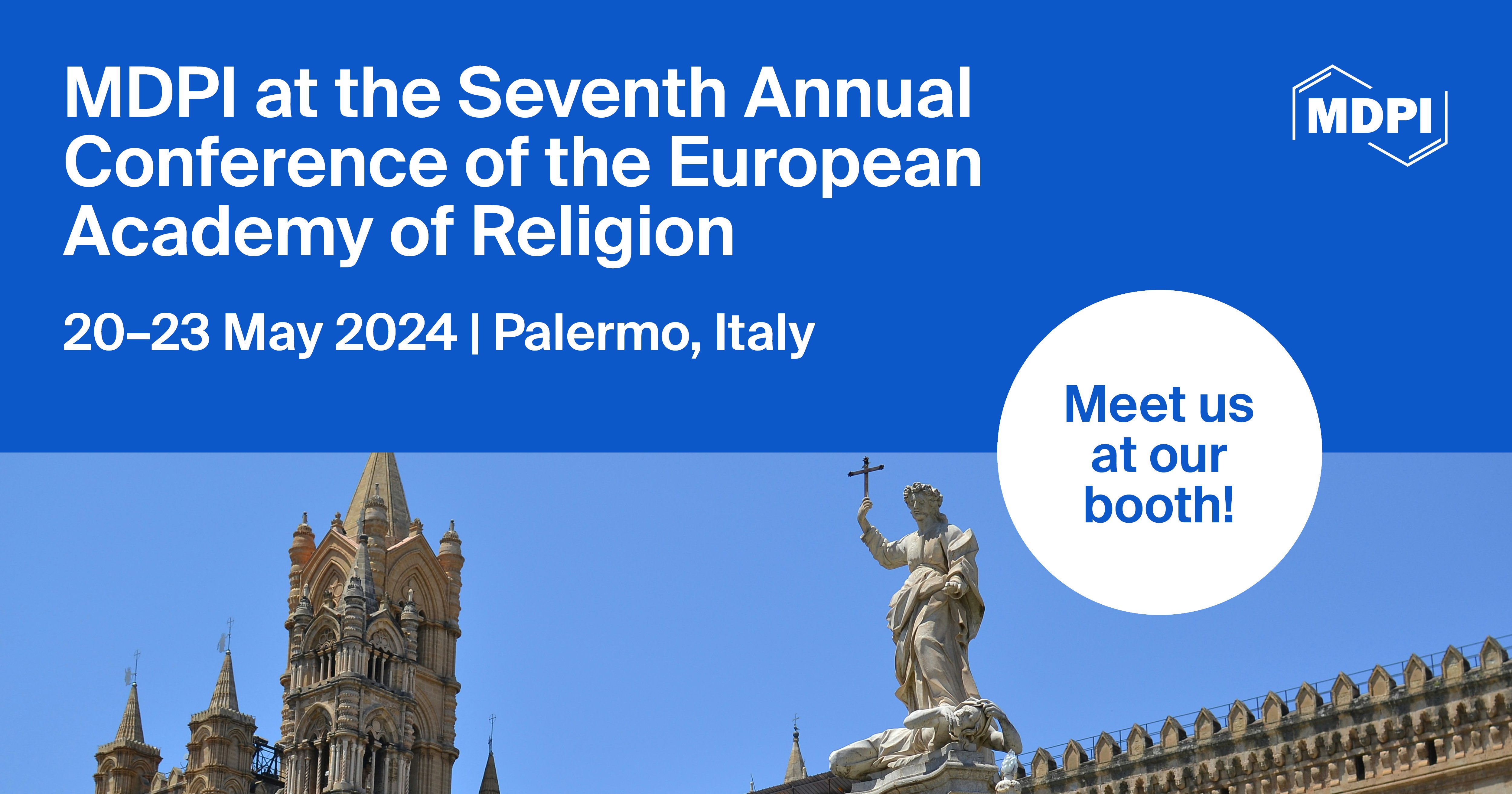Journal Description
Arts
Arts
is an international, peer-reviewed, open access journal promoting significant research on all aspects of the visual and performing arts, published bimonthly online by MDPI.
- Open Access— free for readers, with article processing charges (APC) paid by authors or their institutions.
- High Visibility: indexed within ESCI (Web of Science), and other databases.
- Rapid Publication: manuscripts are peer-reviewed and a first decision is provided to authors approximately 33.7 days after submission; acceptance to publication is undertaken in 8.6 days (median values for papers published in this journal in the second half of 2023).
- Recognition of Reviewers: reviewers who provide timely, thorough peer-review reports receive vouchers entitling them to a discount on the APC of their next publication in any MDPI journal, in appreciation of the work done.
Impact Factor:
0.5 (2022)
Latest Articles
Through the Eyes of the Beholder: Motifs (Re)Interpreted in the 27th Dynasty
Arts 2024, 13(3), 76; https://doi.org/10.3390/arts13030076 (registering DOI) - 23 Apr 2024
Abstract
This paper aims to highlight examples of artistic motifs common throughout Egyptian history but augmented in novel ways during the 27th Dynasty, a time when Egypt was part of the Achaemenid empire and ruled by Persian kings. These kings represented themselves as traditional
[...] Read more.
This paper aims to highlight examples of artistic motifs common throughout Egyptian history but augmented in novel ways during the 27th Dynasty, a time when Egypt was part of the Achaemenid empire and ruled by Persian kings. These kings represented themselves as traditional pharaohs within Egypt’s borders and utilized longstanding Egyptian artistic motifs in their monumental constructions. These motifs, however, were manipulated in subtle ways to send targeted messages to audience(s) of this art. Art historians tend to situate visual styles and motifs within the longue durée of artistic tradition and pick a singular, official, and centralized perspective to narrate the history and reception of that art. In the case of Egypt, this perspective is often that of the king, and there is an assumption that there was a monolithic message sent to his people. But we are not dealing with a homogenous people; a diverse population would have had varied reactions to and interpretations of this visual signaling. By highlighting both the augmentation of traditional motifs undertaken by the Achaemenid administration and the multiplicity of perspectives they held for their audience(s), we can better understand ancient art as being dynamic in function and interpretation, rather than as a static snapshot of carbon-copied royal authority.
Full article
(This article belongs to the Special Issue Ancient Egyptian Art Studies: Art in Motion, a Social Tool of Power and Resistance)
►
Show Figures
Open AccessReview
Resonating Reflections: A Critical Review of Ethnosymbolic Dynamics in Les Six’s Music Nationalism Movement
by
Xuewei Chang, Marzelan Bin Salleh and Jifang Sun
Arts 2024, 13(2), 75; https://doi.org/10.3390/arts13020075 - 22 Apr 2024
Abstract
Les Six and their mentors stirred a debatement of French nationalist music in the early 20th century. However, this movement faced serious criticism and mockery from various quarters and eventually fell apart amid challenges. This critical review explores the ethnosymbolic dynamics within the
[...] Read more.
Les Six and their mentors stirred a debatement of French nationalist music in the early 20th century. However, this movement faced serious criticism and mockery from various quarters and eventually fell apart amid challenges. This critical review explores the ethnosymbolic dynamics within the nationalism music movement of Les Six, and drawing upon ethnomusicological perspectives, the study examines how their compositions reflected and resonated with French national identity and cultural heritage. By analyzing primary sources, scholarly literature, and musical compositions, this article meticulously uncovers the chain reactions generated in the process of constructing national identity and cultural identity within this movement by examining the French societal backdrop, musical traditions, as well as the relationships and attitudes among relevant figures in this movement. The conclusions highlight the multifaceted nature of ethnosymbolism in their work, shedding light on the complexities of national identity construction through music.
Full article
(This article belongs to the Section Musical Arts and Theatre)
►▼
Show Figures
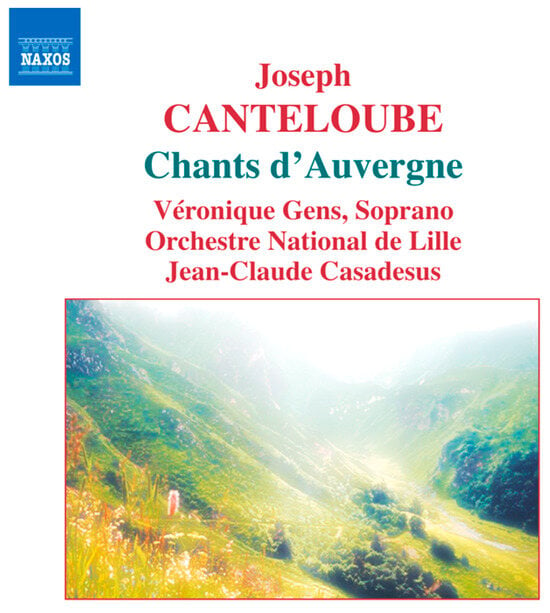
Figure 1
Open AccessArticle
“Only in The History of the Formation of the Self-Conscious Soul Did Bugaev Reveal His Ideas about Music”: Music in the System of Andrei Bely
by
Mikhail Odesskiy and Monika Spivak
Arts 2024, 13(2), 74; https://doi.org/10.3390/arts13020074 - 19 Apr 2024
Abstract
Symbolism distinguished itself in world culture in that its representatives were inclined to a dialogue and intersection of different types of art. In Russian literature, one of the brightest examples of such a synthesis is the work of Andrei Bely (Boris Bugaev; 1880–1934).
[...] Read more.
Symbolism distinguished itself in world culture in that its representatives were inclined to a dialogue and intersection of different types of art. In Russian literature, one of the brightest examples of such a synthesis is the work of Andrei Bely (Boris Bugaev; 1880–1934). The aim of the present article is to consider the writer’s ideas about music itself. As the main source we use Bely’s treatise The History of the Formation of the Self-Conscious Soul. Bely in his Symbolist articles of the 1900s laid down the idea of musical art as an antinomy, which emphasized the troubling importance of the problem, but did not principally imply any positive answer. However, in his anthroposophic treatise The History of the Formation of the Self-Conscious Soul (1926–1931), enormous in volume and scale of the material, the author’s antinomical understanding of music was transformed into a structure which is extremely complicated, but consistent. That is why Andrei Bely does not apply the word “antinomy” to music, but he extensively uses the musical term “counterpoint” (together with other musical terms). Whereas the word “antinomy” pointed at some irreconcilable conflicts, on the contrary, a “counterpoint” introduces these clashes into the frame of a single structure of a system, thus reconciling them. Accordingly, the romance “It is so sweet to be with you” by Mikhail Glinka (called in The History “the greatest genius”) contains, in Andrei Bely’s texts, the message of a wide spectrum.
Full article
(This article belongs to the Special Issue Music vis-à-vis Other Arts in Eastern and Central Europe: Performance, Literature, Theatre, Art/Architecture and Visuality)
►▼
Show Figures
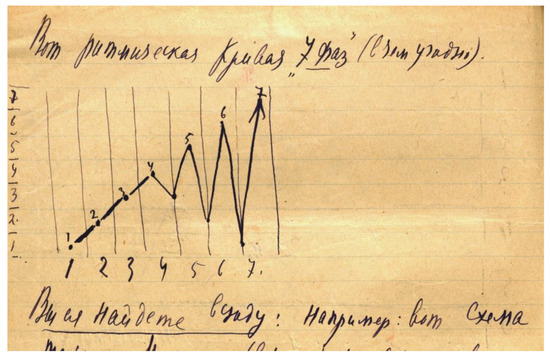
Figure 1
Open AccessArticle
Yes, It Is Polyphony and a Map: Revisiting the 72 Verses of St. Martial
by
Laura Steenberge
Arts 2024, 13(2), 73; https://doi.org/10.3390/arts13020073 - 17 Apr 2024
Abstract
The enigmatic 72 Verses for St. Martial is one of the many works by Ademar de Chabannes (989–1034) crafted to promote the false narrative that St. Martial of Limoges, rather than being a third-century bishop, was actually a first-century apostle. The composition is
[...] Read more.
The enigmatic 72 Verses for St. Martial is one of the many works by Ademar de Chabannes (989–1034) crafted to promote the false narrative that St. Martial of Limoges, rather than being a third-century bishop, was actually a first-century apostle. The composition is visually striking due to the acrostic formed from the first letter of each tercet, MARCIALIS APOSTOLVS XRISTI, and its two overlapping melodies, one in black ink and the other in red. The relationship between the two notations is the subject of debate: Paul Hooreman’s conclusion that they are two variations of the same monophonic chant is countered by Manuel Pedro Ferreira, who argues that Hooreman’s reasoning is insufficient to rule out polyphony. I use Ferreira’s assessment as a jumping-off point for the current analysis, which investigates the compositional processes underlying the creation of the 72 Verses. Hooreman describes many details in the chant as subject to disorganization, scribal error, lack of ability, etc., but when the chant is analyzed polyphonically, these problems resolve. Beyond the music itself, the chant’s unusual polyphonic structure features reveals that the chant is structured around medieval maps, moving between a mappa mundi and the celestial spheres.
Full article
(This article belongs to the Special Issue Medieval Art and Music between Heritage, Modernity, and Multi-Media)
►▼
Show Figures
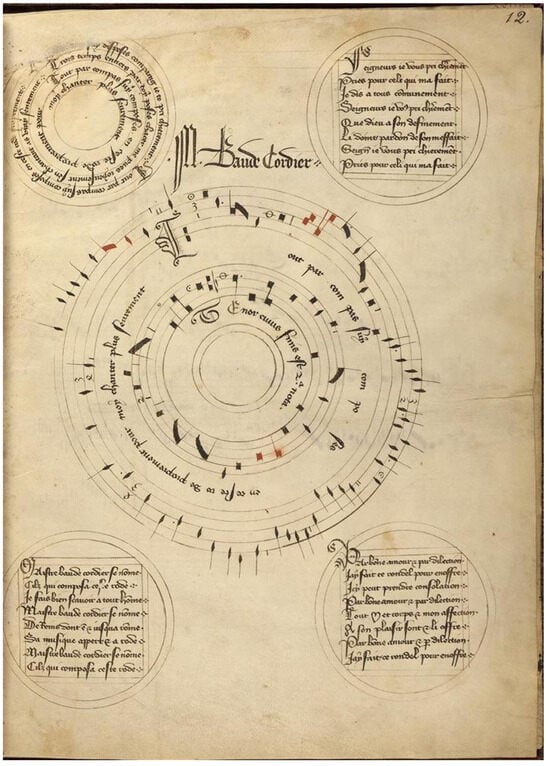
Figure 1
Open AccessArticle
Queer Nightlife and Contemporary Art Networks: A Study of Artists at the Bar
by
Joseph Daniel Valencia
Arts 2024, 13(2), 72; https://doi.org/10.3390/arts13020072 - 10 Apr 2024
Abstract
This article positions queer nightlife as a central vehicle in the lives and practices of queer Latinx artists working in Los Angeles over the past decade. It highlights how queer nightlife has provided a generative space for art making and community building in
[...] Read more.
This article positions queer nightlife as a central vehicle in the lives and practices of queer Latinx artists working in Los Angeles over the past decade. It highlights how queer nightlife has provided a generative space for art making and community building in LA and considers how the usage of queer nightlife as a frame of study ruptures existing art historical and curatorial methodologies relative to Latinx art. I closely analyze works by artists rafa esparza, Sebastian Hernandez, and Gabriela Ruiz drawn from the gay bars and streets of downtown and East Los Angeles to underscore the radical and sophisticated ways by which these artists create art, community, and opportunity. By critically examining three case studies—Escandalos Angeles (2018), a performance by Hernandez and Ruiz at Club Chico in Montebello, California; Nostra Fiesta (2019), a storefront mural by esparza, Ruiz, and friends at the New Jalisco Bar in downtown; and YOU (2019–ongoing), a queer party directed by Hernandez and launched at La Cita Bar in downtown—I reveal how queer nightlife has served as an incubator for these artists to come together, express themselves, and generate a sense of joy and freedom from the struggles of everyday life.
Full article
(This article belongs to the Special Issue Queer Latinx Artists and the Human Body)
►▼
Show Figures
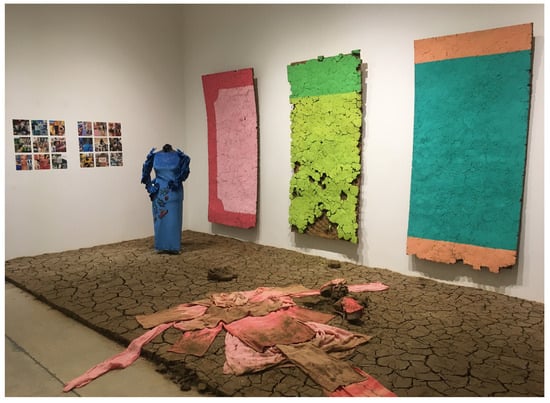
Figure 1
Open AccessArticle
A Child Burial from Kerch: Mortuary Practices and Approaches to Child Mortality in the North Pontic Region between the 4th Century BCE and the 1st/2nd Century CE
by
Joanna Porucznik and Evgenia Velychko
Arts 2024, 13(2), 71; https://doi.org/10.3390/arts13020071 - 10 Apr 2024
Abstract
This article discusses a poorly studied child elite burial discovered in 1953 at the necropolis of Panticapaeum, situated near the modern city of Kerch, Crimea. A reassessment of previous research is urgently needed since it did not offer an analysis of Bosporan society
[...] Read more.
This article discusses a poorly studied child elite burial discovered in 1953 at the necropolis of Panticapaeum, situated near the modern city of Kerch, Crimea. A reassessment of previous research is urgently needed since it did not offer an analysis of Bosporan society from the perspective of childhood studies in general and local approaches to child mortality in particular. This fresh approach sheds new light on social structures and transformations within the northern Black Sea region. A broad chronological and geographical perspective is provided in order to detect changing mortuary rituals regarding deceased children in relation to shifting socio-political situations among North Pontic Greek and non-Greek societies. A survey of current social interpretations concerning the (in)visibility of children in the mortuary customs, particularly between the 4th century BCE and the 1st/2nd century CE, is followed by a detailed description of the history of research in the Panticapaeum necropolis. A comprehensive analysis of the grave goods that accompanied the deceased child is also provided. The discussed material suggests that a new form of elite self-representation, expressed through mortuary rites, appeared around the turn of the first millennium. This included a different approach to deceased children, whose ascribed status and expected, yet unfulfilled, social roles were frequently displayed by the family through the funerary ceremony.
Full article
(This article belongs to the Special Issue Situating Eurasia in Antiquity: Nomadic Material Culture in the First Millennium BCE)
►▼
Show Figures
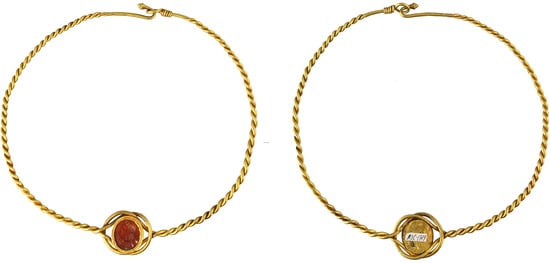
Figure 1
Open AccessArticle
Social Choreography as a Cultural Commoning Practice: Becoming Part of Urban Transformation in Une danse ancienne
by
Johanna Hilari and Julia Wehren
Arts 2024, 13(2), 70; https://doi.org/10.3390/arts13020070 - 09 Apr 2024
Abstract
This article examines social choreography as a cultural commoning practice that is embedded within a relational structure between different institutions, the people involved, and specific socio-cultural contexts. The artistic research project Une danse ancienne by French choreographer Rémy Héritier and their team is
[...] Read more.
This article examines social choreography as a cultural commoning practice that is embedded within a relational structure between different institutions, the people involved, and specific socio-cultural contexts. The artistic research project Une danse ancienne by French choreographer Rémy Héritier and their team is presented as a case study of this practice. This collaborative choreography is based on a dance performance and social gathering that is reactivated every year by the same dancer in the same peri-urban site in a metropolitan area of Lausanne, Switzerland. Une danse ancienne holds strong relationships to temporalities, to the changing urban space, and to communal processes of documentation. Its relational choreographic structure and sharing practices are analyzed against the concepts of ‘expanded choreography’ and ‘cultural commoning’. This article, therefore, discusses social choreography as a cultural commoning practice that involves interactions with different social groups and institutions and practices of sharing and communal documentation. This article shows how, as social choreography, Une danse ancienne reflects upon urban transformation through cultural commoning practices.
Full article
(This article belongs to the Special Issue Choreographing Society)
Open AccessCorrection
Correction: Peña Torres (2024). La Liga de la Decencia: Performing 20th Century Mexican History in 21st Century Texas. Arts 13: 47
by
Jessica Peña Torres
Arts 2024, 13(2), 69; https://doi.org/10.3390/arts13020069 - 07 Apr 2024
Abstract
In the original publication (Peña Torres 2024), (Belliveau and Lea 2016) was not cited and its related reference was also omitted [...]
Full article
(This article belongs to the Special Issue Exploring Research-Based Theatre within Contemporary Theatre Education)
Open AccessArticle
From Leonardo to Caravaggio: Affective Darkness, the Franciscan Experience and Its Lombard Origins
by
Anne H. Muraoka
Arts 2024, 13(2), 68; https://doi.org/10.3390/arts13020068 - 06 Apr 2024
Abstract
The function of affectivity has generally focused on post-Council of Trent paintings, where artists sought a new visual language to address the imperative function of sacred images in the face of Protestant criticism and iconoclasm, either guided by the Council’s decree on images,
[...] Read more.
The function of affectivity has generally focused on post-Council of Trent paintings, where artists sought a new visual language to address the imperative function of sacred images in the face of Protestant criticism and iconoclasm, either guided by the Council’s decree on images, post-Tridentine treatises on sacred art, or by the Counter-Reformation climate of late Cinquecento and early Seicento Italy. This essay redirects the origins of the transformation of the function of chiaroscuro from objective to subjective, from corporeal to spiritual, and from rational to affective to a much earlier period in late Quattrocento and early Cinquecento Milan with Leonardo da Vinci. By tracing the transformation of chiaroscuro as a vehicle of affect beginning with Leonardo’s Virgin of the Rocks, it will become evident that chiaroscuro became a device used to focalize the viewers’ experience dramatically and to move viewers visually and mystically toward unification with God under the influence of the Franciscans.
Full article
(This article belongs to the Special Issue Affective Art)
►▼
Show Figures

Figure 1
Open AccessArticle
The Power of Convening: Towards an Understanding of Artist-Led Collective Practice as a Convener of Place
by
John David Wright
Arts 2024, 13(2), 67; https://doi.org/10.3390/arts13020067 - 05 Apr 2024
Abstract
In recent years, there has been a growing interest in artist-led collectives with high-profile recognition within contemporary art mega festivals, prizes, and biennials. Yet, these amorphous entities and initiatives tend to be framed either through their politically motivated actions or as a critique
[...] Read more.
In recent years, there has been a growing interest in artist-led collectives with high-profile recognition within contemporary art mega festivals, prizes, and biennials. Yet, these amorphous entities and initiatives tend to be framed either through their politically motivated actions or as a critique of the notion of the single author or ‘artist-as-genius’ mythology. This article builds upon this discourse to shift the emphasis onto both interpersonal and socio-political relationships that constitute artist-led collectives in order to explore their complex role in convening and placemaking and what this might mean for both policymaking and research.
Full article
(This article belongs to the Special Issue Visual Arts and Design: Practice-Based Research)
Open AccessArticle
“Spaces of Silence” and “Secret Music of the Word”: Verbo-Musical Minimalism in the Poetry of Gennady Aygi and Elizaveta Mnatsakanova
by
Olga Sokolova and Vladimir Feshchenko
Arts 2024, 13(2), 66; https://doi.org/10.3390/arts13020066 - 31 Mar 2024
Abstract
Two major poets of the Russian Neo-Avant-Garde—Gennady Aygi and Elizaveta Mnatsakanova—created textual works that transgressed the limits of language and the borders between the arts. Each pursued their own method of the visualization and musicalization of verbal matter, yet both share a particular
[...] Read more.
Two major poets of the Russian Neo-Avant-Garde—Gennady Aygi and Elizaveta Mnatsakanova—created textual works that transgressed the limits of language and the borders between the arts. Each pursued their own method of the visualization and musicalization of verbal matter, yet both share a particular musical sensibility, which guarantees the integrity of the linguistic structure of their verse, despite the fragmentation and logical incoherence of its elements. The atonal (serial) musical tradition has a special significance for these experimental poetics of minimalism. Mnatsakanova, herself a musicologist, who was friends with Dmitri Shostakovich, not only used the techniques of contemporary music composition in her visual and sound poetry, but also collaborated with electronic musicians in her recorded poetry performances. Aygi experimented with language, not only crossing the boundaries between music and poetry, but also between sound and silence. For him, music was a way of expressing pre-verbal subjectivity and reproducing signs of meaning that are hidden from ordinary perception. In his poems, Aygi brought together Chuvash folk music with experimental techniques of minimalism, correlating his own work with such Soviet unofficial composers as Andrey Volkonsky and Sofia Gubaidulina. This paper will address the issues of transmutation between verbal, visual, and sound art in poetic minimalism of the Soviet-era underground.
Full article
(This article belongs to the Special Issue Music vis-à-vis Other Arts in Eastern and Central Europe: Performance, Literature, Theatre, Art/Architecture and Visuality)
►▼
Show Figures

Figure 1
Open AccessArticle
The Protection of Monuments and Immoveable Works of Art from War Damage: A Comparison of Italy in World War II and Ukraine during the Russian Invasion
by
Cathleen Hoeniger
Arts 2024, 13(2), 65; https://doi.org/10.3390/arts13020065 - 31 Mar 2024
Abstract
This article compares the safeguarding of monuments and immoveable works of art in Italy in the first years of World War II to the on-site protection undertaken in Ukraine during the Russian invasion and explores whether traditional or more innovative methods are being
[...] Read more.
This article compares the safeguarding of monuments and immoveable works of art in Italy in the first years of World War II to the on-site protection undertaken in Ukraine during the Russian invasion and explores whether traditional or more innovative methods are being employed in Ukraine. Both the planning in advance of war and the implementation of protective measures amidst substantial obstacles are considered. The focus is placed on fixed works of art in churches and public statues. Special attention is given to the vulnerability of churches and their ornamentation during war.
Full article
(This article belongs to the Special Issue Ukraine Under Fire: The Visual Arts in Ukraine and Abroad Since 2014)
►▼
Show Figures
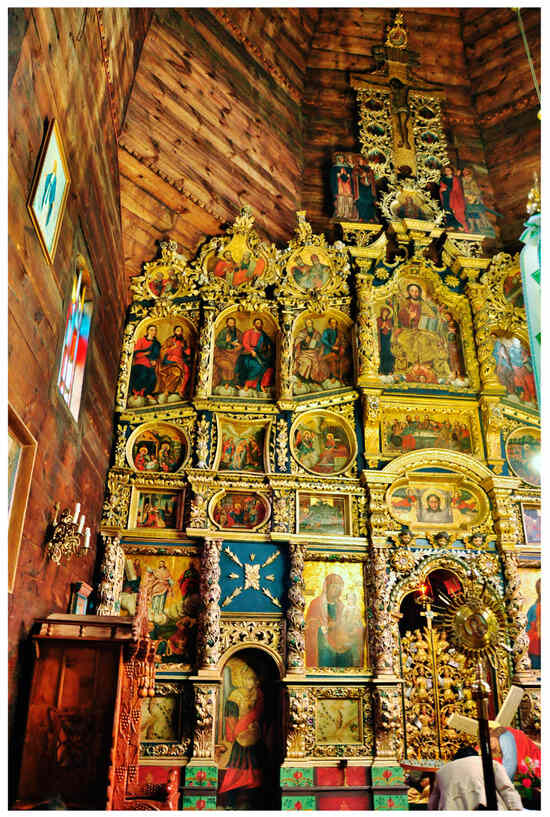
Figure 1
Open AccessArticle
Taking the Deer by the Antlers: Deer in Material Culture in the Balkan Neolithic
by
Selena Vitezović
Arts 2024, 13(2), 64; https://doi.org/10.3390/arts13020064 - 30 Mar 2024
Abstract
Prehistoric communities had strong ties with the animal world that surrounded them—animals were prey, sources of food, and raw materials, but also threats and mysteries, and certain animals often had an important place in the symbolic realm. With the process of domestication and
[...] Read more.
Prehistoric communities had strong ties with the animal world that surrounded them—animals were prey, sources of food, and raw materials, but also threats and mysteries, and certain animals often had an important place in the symbolic realm. With the process of domestication and the switch to animal husbandry as the main source of animal food, these relations changed considerably, and a certain dichotomy between “the domestic” and “the wild” may be noted in numerous past communities. When it comes to the Neolithic period in the Balkans, domestic animals had an important place in subsistence and economy, and it seems that cattle had a particularly prominent symbolic role. Wild species preserved some of their significance in both subsistence and symbolic realms, especially cervids (red deer, roe deer, and fallow deer). In this paper, the place of deer in the material culture of the Neolithic communities in the Balkans will be analysed: skeletal elements of deer were used for the production of diverse items, including non-utilitarian ones, or were part of ritual depositions, and deer representations are encountered in other materials, such as clay figurines. The symbolic meaning of deer cannot be reconstructed with certainty; however, it is probable that deer were tied with territoriality and the landscape.
Full article
(This article belongs to the Special Issue Animals in Ancient Material Cultures (vol. 3))
►▼
Show Figures
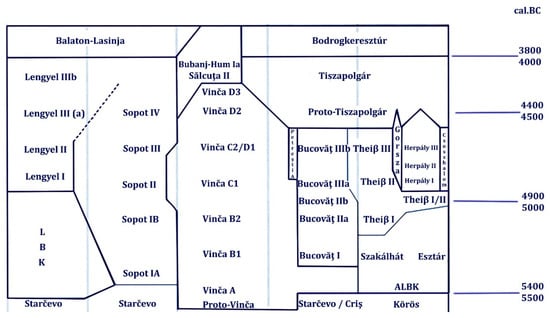
Figure 1
Open AccessArticle
Applied Theatre: Research-Based Theatre, or Theatre-Based Research? Exploring the Possibilities of Finding Social, Spatial, and Cognitive Justice in Informal Housing Settlements in India, or Tales from the Banyan Tree
by
Selina Busby
Arts 2024, 13(2), 63; https://doi.org/10.3390/arts13020063 - 29 Mar 2024
Abstract
This article draws on a twenty-year relationship of short-term interventions with Dalit communities living in informal settlements, sub-cities and urban villages in Mumbai, that have sought to create public theatre events based on research by and with communities that celebrate, problematise and interrogate
[...] Read more.
This article draws on a twenty-year relationship of short-term interventions with Dalit communities living in informal settlements, sub-cities and urban villages in Mumbai, that have sought to create public theatre events based on research by and with communities that celebrate, problematise and interrogate sustainable urban living. In looking back over the developments and changes to our working methods in Mumbai, I explore how the projects priorities the roles of the community as both researchers and artists. I consider where a specific applied theatre project, which focuses on site specific storytelling with Dalit communities in Worli Koliwada and Dharavi, functions on a continuum of interactive, participatory, and emancipatory practice, research and performance. Applied Theatre practices should not and cannot remain static, they need to be constantly reformed and as practitioners and researchers we need to constantly re-examine the ways in which we work. This chapter poses two central questions: firstly, can this long-term partnership between practitioners, researchers and artists from the UK and India working with community members genuinely be a space for co-creating knowledge and theatre? And secondly, if so, is this Theatre-based Research or Research Based Theatre? I interrogate Applied Theatre’s potential to create a space of cognitive justice, which must be the next step for applied theatre, along-side its more widely accepted aims of searching for social and spatial justice and which places the community as both artists and researchers. The Dalit social reality is one of oppression, based on three axes: social, economic and gender. The chapter explores how working as co-researchers and the public performance of their stories has been a form of ‘active citizenship’ for these participants and is a key part of their strategy in their demand for policy changes. In looking forward I ask how working in international partnerships with community members can promote cognitive justice and go beyond a merely participatory practice. I consider why it is vital for the field that applied theatre practice includes partners from both the global south and north working together to co-create knowledge, new methods of practice to ensure an applied theatre knowledge democracy. In doing so I will discuss if and how this work might be considered to be Theatre-based Research.
Full article
(This article belongs to the Special Issue Exploring Research-Based Theatre within Contemporary Theatre Education)
Open AccessArticle
The 60 Years of Queer and Trans Activism and Care Project: Learning to Conduct Archival Research and Write Dramatic Verbatim Monologues
by
Tara Goldstein and Jenny Salisbury
Arts 2024, 13(2), 62; https://doi.org/10.3390/arts13020062 - 29 Mar 2024
Abstract
This reflective essay describes a research course which provided undergraduate students with an opportunity to conduct archival research on six decades of queer, trans, Black, Indigenous, and People of Colour (QTBIPOC) activism and care that have challenged heteronormativity, cis-normativity, and racism in Canada.
[...] Read more.
This reflective essay describes a research course which provided undergraduate students with an opportunity to conduct archival research on six decades of queer, trans, Black, Indigenous, and People of Colour (QTBIPOC) activism and care that have challenged heteronormativity, cis-normativity, and racism in Canada. While there are many ways to share the findings of archival research, we chose to teach our students how to create dramatic verbatim monologues as the arts-based research method of verbatim theatre required students to use the words of activists themselves to explain why a particular moment of activism and care was needed. Students attended three different workshops during the full-year course from September 2022 to March 2023: a workshop in conducting archival research, a workshop about centring themselves and their communities in their research, and a workshop in verbatim monologue writing. Here, we reflect upon what these workshops taught us about archival research, working with Indigenous archival material, and rupturing systems of oppression in our own bodies. At the end of the course, students reported their take-aways from the course. This included a new understanding that it was possible to conduct research on topics they felt passionate about and that theatre-based research provided them with a way to express the findings of their research in forms other than writing essays. This new-found freedom was life-changing.
Full article
(This article belongs to the Special Issue Exploring Research-Based Theatre within Contemporary Theatre Education)
Open AccessArticle
Haunted Monasteries: Troubling Indigenous Erasure in Early Colonial Mexican Architecture
by
Savannah Esquivel
Arts 2024, 13(2), 61; https://doi.org/10.3390/arts13020061 (registering DOI) - 29 Mar 2024
Abstract
This essay examines the placement and displacement of Nahua labor in the architectural history of Mexico’s early colonial monasteries. It takes as its point of departure the story of a ghost in the Tlaxcala monastery as told by a Franciscan missionary to analyze
[...] Read more.
This essay examines the placement and displacement of Nahua labor in the architectural history of Mexico’s early colonial monasteries. It takes as its point of departure the story of a ghost in the Tlaxcala monastery as told by a Franciscan missionary to analyze the discursive and spatial dimensions of emergent racial ideologies in Mexico’s earliest Catholic missions. While the ghost’s appearance signals the eruption of unresolved tensions between the missionaries and the Tlaxcalans in a cohabited religious complex, the specter also animates settler colonial domination. Cross-referencing Nahuatl and Franciscan documents reveal the ghost story as a whitewashed tale of monastic ritual life wherein the ghost effaces Indigenous labor at precisely the moments and places missionaries deemed it most threatening. In so doing, this study illuminates how racial ideologies were structured discursively and experientially at the missions and contributes to urgent debates about how the history and preservation of Catholic architecture in Mexico conceals and represses the lived experience of Indigenous peoples.
Full article
(This article belongs to the Special Issue Race and Architecture in the Iberian World, c. 1500-1800s)
►▼
Show Figures
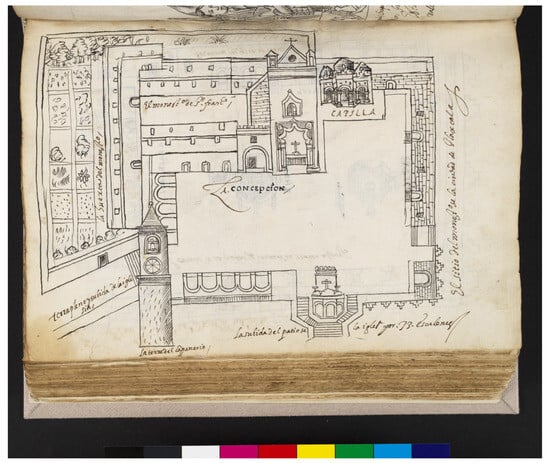
Figure 1
Open AccessArticle
Replacing Settler Spaces: The Transformational Power of Indigenous Public Art
by
Megan A. Smetzer
Arts 2024, 13(2), 60; https://doi.org/10.3390/arts13020060 - 28 Mar 2024
Abstract
Similar to 19th-century steamship travel, 21st-century cruise ships link far-flung communities for visitors to the Pacific Northwest Coast. Contemporary Indigenous artists, like their ancestors before them, have transformed touristic curiosity into economic, educational and cultural opportunities for their communities. Public art has become
[...] Read more.
Similar to 19th-century steamship travel, 21st-century cruise ships link far-flung communities for visitors to the Pacific Northwest Coast. Contemporary Indigenous artists, like their ancestors before them, have transformed touristic curiosity into economic, educational and cultural opportunities for their communities. Public art has become an increasingly important site for engaging visitors who have only a few hours to spend on shore. This paper compares two public art projects—Juneau, Alaska’s Kootéeyaa Deiyí (Totem Pole Trail) and Vancouver, British Columbia’s Blanketing the City—to explore the multivalent ways in which public art expresses Indigenous sovereignty.
Full article
(This article belongs to the Special Issue Arts of the Northwest Coast)
►▼
Show Figures
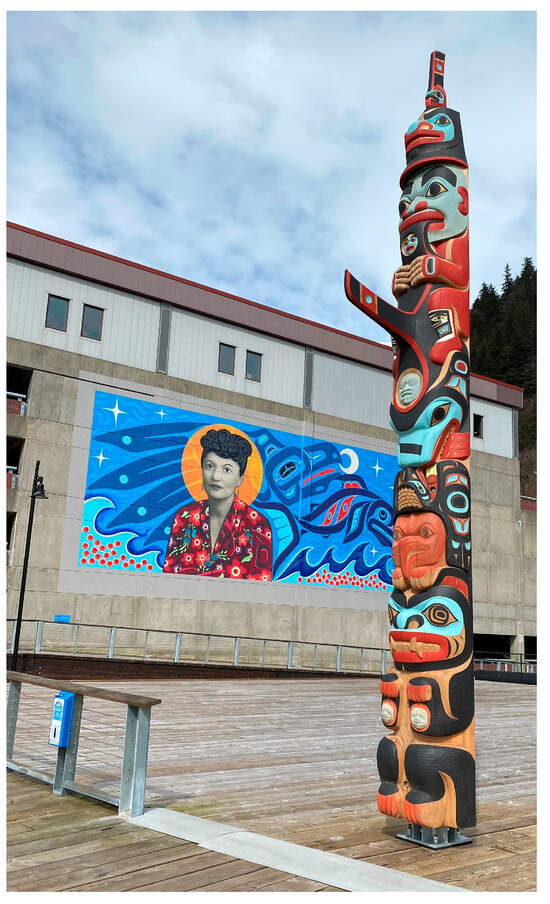
Figure 1
Open AccessArticle
Rethinking Conceptual Parameters of Choreography (in Social Spaces)—Actualization of Intensities in Discursive Fields
by
Kirsi Monni
Arts 2024, 13(2), 59; https://doi.org/10.3390/arts13020059 - 21 Mar 2024
Abstract
This article aims to take part in the ongoing discussion on the social and political potentialities as well as the conceptual premises of choreography and to contribute to the discussion about world relations in the choreographed movement. The much-used definition of Western choreography
[...] Read more.
This article aims to take part in the ongoing discussion on the social and political potentialities as well as the conceptual premises of choreography and to contribute to the discussion about world relations in the choreographed movement. The much-used definition of Western choreography is “organized movement in space and time”. Although this definition always applies, it does not specify the world relations and worldmaking capacities of the choreographed movement. The main focus of this article is an ontological rethinking of the basic concepts of choreography: movement, space, time and organization, with the addition of kinaesthetic fields, kinaesthetic and spatial intelligence, virtual and actual realms, striated and smooth spaces (Deleuze and Guattari) and different conceptions of time. By analyzing these concepts, the aim is to provide a view of ontologically elementary units in choreography (such as a change in space, the difference over time and space, and passage to shared actuality), with a wider understanding of the inherent social relationality in choreographed movement. After discussing these topics, a few social choreography events and protests are described to represent different choreographic aims and organizational modes arising from each specific situation. The article concludes by proposing that choreography could be seen as organizing movement in space and time but also as a choreographic actualization of intensities in different discursive fields.
Full article
(This article belongs to the Special Issue Choreographing Society)
Open AccessArticle
“[…] Un Tout Petit Peu de Dufayel”—Picasso, 1910–1914
by
Laurence Madeline
Arts 2024, 13(2), 58; https://doi.org/10.3390/arts13020058 - 21 Mar 2024
Abstract
Picasso twice quoted the name of Dufayel, once in relation with the name of the Louvre and once for the same period of his career, between 1910 and 1914. This essay explores the universe created by the businessman Georges Dufayel in order to
[...] Read more.
Picasso twice quoted the name of Dufayel, once in relation with the name of the Louvre and once for the same period of his career, between 1910 and 1914. This essay explores the universe created by the businessman Georges Dufayel in order to understand the role it played in Picasso’s evolving cubism from that of analytic to synthetic.
Full article
(This article belongs to the Special Issue Picasso Studies (50th Anniversary Edition))
►▼
Show Figures
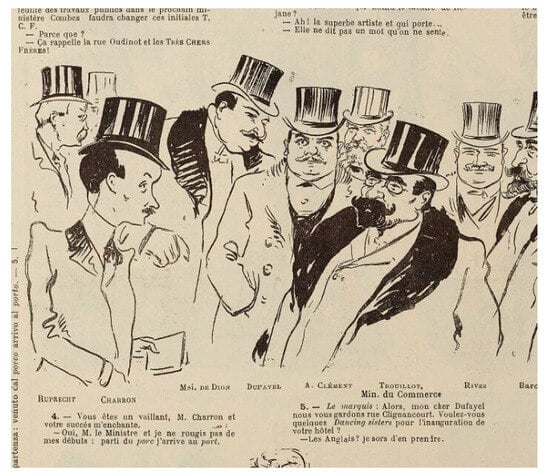
Figure 1
Open AccessArticle
Violent Raiding, Systematic Slaving, and Sweeping Depopulation? Re-Evaluating the Scythian Impact on Central Europe through the Lens of the Witaszkowo/Vettersfelde Hoard
by
Louis D. Nebelsick
Arts 2024, 13(2), 57; https://doi.org/10.3390/arts13020057 - 14 Mar 2024
Abstract
In 1882, the lavishly decorated golden regalia of a steppe nomad warrior prince, which was crafted in the late sixth century BCE in a “bilingual” Scythian–Milesian workshop on the Black Sea coast, was found on the edge of a Lusatian swamp 120 km
[...] Read more.
In 1882, the lavishly decorated golden regalia of a steppe nomad warrior prince, which was crafted in the late sixth century BCE in a “bilingual” Scythian–Milesian workshop on the Black Sea coast, was found on the edge of a Lusatian swamp 120 km southeast of Berlin. Its discovery and the ongoing findings of steppe nomad armaments—arrows, battle axes, and swords—in central Europe have led to a lively debate about the nature of Scythian–Indigenous interaction in the Early Iron Age, ranging from benign visions of long-term acculturation to violent scenarios of short-term raiding. In this article, I argue that an analysis of the iconography of the Witaszkowo hoard and new information from excavations at its find spot make it likely that it was sent as a diplomatic gift by Scythian elites to an indigenous leader and deposited by the local community as a votive hoard. An affirmation of the compact chronological range of Scythian artefacts found in the west, growing evidence for the destruction of indigenous strongholds by horse-borne archers, and concurrent evidence for the drastic depopulation of vast landscapes in the second half of the sixth century BCE allow us to envisage the gifting of this hoard as an episode of a fierce and destructive altercation. It is posited that this onslaught was a facet of the western thrust of the Lydian and Persian Empires, and that its extirpative impact was the result of systematic, commercially driven slaving triggered by the concurrent monetisation of the economies of the Black Sea coast. The effects of these raids on Eastern Central Europe’s later prehistoric communities are made manifest by analogies to the disastrous ramifications of the transatlantic slave trade on societies of 16th-to-18th-century West Africa.
Full article
(This article belongs to the Special Issue Situating Eurasia in Antiquity: Nomadic Material Culture in the First Millennium BCE)
►▼
Show Figures
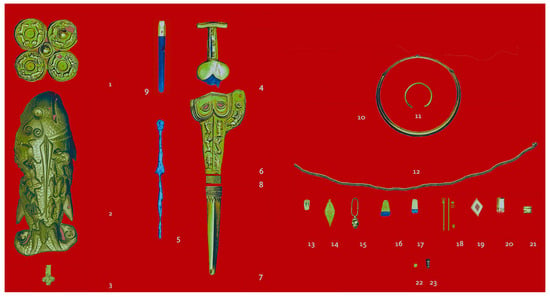
Figure 1
Highly Accessed Articles
Latest Books
E-Mail Alert
News
Topics

Conferences
Special Issues
Special Issue in
Arts
Black Artists in the Atlantic World
Guest Editors: Paul Niell, Emily ThamesDeadline: 30 April 2024
Special Issue in
Arts
NFTs, Blockchain, Cryptocurrency, Metaverse: The Web3 Revolution That Has Transformed the Art Market
Guest Editor: Elena SidorovaDeadline: 1 June 2024
Special Issue in
Arts
French Art and Culture from the 1780s to the 1900s
Guest Editor: Nina Athanassoglou-KallmyerDeadline: 30 June 2024
Special Issue in
Arts
Cultural Diplomacy and Informal Artistic Relations in East Central Europe in the 20th Century: A Global Perspective
Guest Editor: Irena KossowskaDeadline: 31 July 2024
Topical Collections
Topical Collection in
Arts
Review of Machine Art
Collection Editors: Frederic Fol Leymarie, Marian Mazzone, Marie Vicet, G. W. Smith
Topical Collection in
Arts
Contemporary Glass Art: Materiality and Digital Technologies
Collection Editor: Jessamy Kelly

